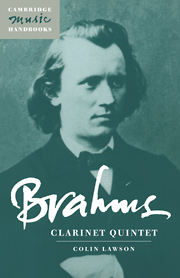Book contents
- Frontmatter
- Contents
- List of illustrations
- Preface
- 1 The nineteenth-century clarinet and its music
- 2 Brahms and the orchestral clarinet
- 3 Brahms's chamber music before 1891
- 4 The genesis and reception of the Clarinet Quintet
- 5 Design and structure
- 6 Performance practice
- 7 The legacy of Brahms's clarinet music
- Appendix 1 A list of Brahms's chamber music
- Appendix 2 A review of the first London performance,The Times,29 March 1892
- Appendix 3 The mechanism of Mühlfeld's Baermann-Ottensteiner clarinets
- Notes
- Select bibliography
- Index
4 - The genesis and reception of the Clarinet Quintet
Published online by Cambridge University Press: 05 June 2012
- Frontmatter
- Contents
- List of illustrations
- Preface
- 1 The nineteenth-century clarinet and its music
- 2 Brahms and the orchestral clarinet
- 3 Brahms's chamber music before 1891
- 4 The genesis and reception of the Clarinet Quintet
- 5 Design and structure
- 6 Performance practice
- 7 The legacy of Brahms's clarinet music
- Appendix 1 A list of Brahms's chamber music
- Appendix 2 A review of the first London performance,The Times,29 March 1892
- Appendix 3 The mechanism of Mühlfeld's Baermann-Ottensteiner clarinets
- Notes
- Select bibliography
- Index
Summary
Brahms and Meiningen
Richard Mühlfeld's career was centred around his membership of the Meiningen orchestra, whose special and intimate characteristics have already been remarked upon in Chapter 2. During 1880–5 Hans von Billow did much to raise its profile and he frequently programmed Brahms's music at the internationally renowned festivals of orchestral music in the city. Brahms's personal connection with the orchestra began in 1881, when he visited Meiningen to give a performance of his Second Piano Concerto. Subsequently the duke invited Brahms frequently to the castle, where he spent Christmas as a guest in both 1887 and 1888. During von Bülow's tenure as conductor Brahms is known to have made the acquaintance of Richard Mühlfeld at a rehearsal. Edwin Evans regarded the subsequent delay before the appearance of the clarinet works as ‘allowing room for considerable thought having intervened – an amount, in fact, which we can only interpret as hesitation’. Furthermore, a letter to Clara Schumann of July 1891 indicates that prior to his friendship with Mühlfeld, Brahms considered that during his own lifetime the art of clarinet playing had deteriorated.
However, there may in fact have been some activity during Evans's so-called period of hesitation, with even the possibility that Brahms started work on a clarinet quintet in E minor. On 14 December 1888 Brahms wrote to Clara Schumann confirming that he expected to be able come to the Frankfurt Museum for a concert on 11 January the following year:
But why is it to be a Brahms evening this time? Neither for myself nor for anybody else is this either necessary or desirable. […]
- Type
- Chapter
- Information
- Brahms: Clarinet Quintet , pp. 31 - 46Publisher: Cambridge University PressPrint publication year: 1998



